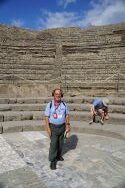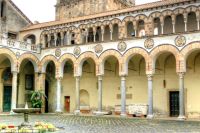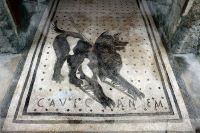The ultimate melting pot—Pompeii
August 13, 2017
We’ve spent the three days in the shadow of Papa Vesuvius, along the Amalfi Coast, one of the most scenic parts of Italy. Two days were in Salerno, where the highlights were the Greco-Roman ruins discovered in the 18th century when Carlos VII, a Bourbon, was King of the Two Sicilies and interested in antiquities.
I’ve already written about Paestum, but the next day we went to a more 
 spectacular discovery—Pompeii, literally a “melting pot.” The eruption of Mt. Vesuvius on August 24, 79 AD created one of the most well-known archaeological sites—Pompeii. Over two days, a city that once housed 26,000 people got buried, to be rediscovered almost 1600 years later.
spectacular discovery—Pompeii, literally a “melting pot.” The eruption of Mt. Vesuvius on August 24, 79 AD created one of the most well-known archaeological sites—Pompeii. Over two days, a city that once housed 26,000 people got buried, to be rediscovered almost 1600 years later.
In two hours, we barely scratched the surface, but we did see the major public buildings including the forum, the center of any Roman city, 
 the market (with a stand that measured weights), the local happy house (there were six in the city), the walls that enclosed it, and so forth. I was a little disappointed to realize
the market (with a stand that measured weights), the local happy house (there were six in the city), the walls that enclosed it, and so forth. I was a little disappointed to realize


that much of the artwork got taken to the museum in Naples that we are not visiting, but there was enough to help the 2.5 million tourists who visit the site get a real feel for Roman civilization. I was interested in the temples devoted to Augustus (as well as Jupiter and the other traditional gods), because he was recently declared emperor, and began the tradition of emperor king. We also saw the kind of “Home Depot” store, which housed amphoras and other items of everyday life, and had several casts of the dead, including a dog, that died in the “melting pot.”
 We had enough time when we got back for me to take Carolyn to the St. Matthews Cathedral, which is another site not to be missed. She noted it was bright inside, but that’s due in part to its origins in the 11th century, with a huge iron gate cast in Constantinople; I was also impressed with the Arab-Norman cloister, as I mentioned. In addition, one of the chapels in the church is called the “chapel of the Crusaders,” who
We had enough time when we got back for me to take Carolyn to the St. Matthews Cathedral, which is another site not to be missed. She noted it was bright inside, but that’s due in part to its origins in the 11th century, with a huge iron gate cast in Constantinople; I was also impressed with the Arab-Norman cloister, as I mentioned. In addition, one of the chapels in the church is called the “chapel of the Crusaders,” who  stopped there to have their weapons blessed before embarking on the Crusades.
stopped there to have their weapons blessed before embarking on the Crusades.
We’ve not been too worried about Vesuvius (though with 2 million people living in Naples, its next explosion could certainly make Pompeii seem small), but our captain has been sensitive to the winds that escaped from the Aeolian Islands. Rough seas postponed our departure from Salerno, and we took a short bus ride to Vietri, the entrance to the  Amalfi Coast. A small town, it’s best known for its ceramics, which cover the dome of the parish church, and call out from half the shops in town for a stop and look. I found a trivet that copies the famous Pompeii sign “Beware of Dog” (Cave Canem) that greatly delighted Carolyn. It will certainly find a place in our kitchen!
Amalfi Coast. A small town, it’s best known for its ceramics, which cover the dome of the parish church, and call out from half the shops in town for a stop and look. I found a trivet that copies the famous Pompeii sign “Beware of Dog” (Cave Canem) that greatly delighted Carolyn. It will certainly find a place in our kitchen!